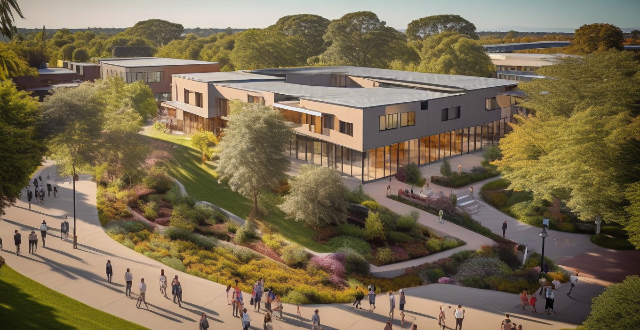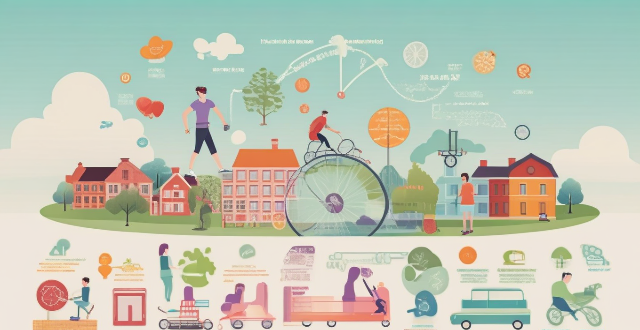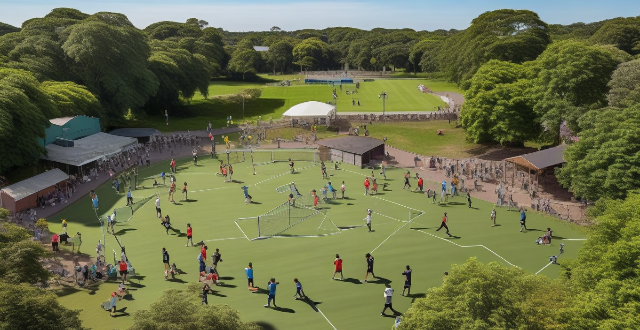Community Organization

What role do sports organizations play in fostering community engagement and participation ?
The text discusses the role of sports organizations in fostering community engagement and participation. It highlights their contributions in various areas including community building, educational outreach, economic impact, and social responsibility. Sports organizations promote social interaction by offering memberships, organizing events, and providing volunteer opportunities. They enhance diversity and inclusion through inclusive policies, adaptive sports programs, and cultural celebrations. In terms of educational outreach, they promote health and wellness through fitness programs, workshops, and school collaborations. They also develop life skills such as leadership, character development, and career opportunities. Sports organizations stimulate local economies by hosting tournaments and events, promoting sports tourism, and creating jobs. They support local businesses through partnership programs, community marketplaces, and merchandise sales. Additionally, sports organizations demonstrate social responsibility by adopting green initiatives, planning eco-friendly events, launching educational campaigns, organizing fundraising events, having athlete ambassadors, and offering matching gift programs. Overall, sports organizations play a crucial role in building social connections, enhancing diversity and inclusion, providing educational outreach, stimulating local economies, and embracing social responsibility.

What are some successful examples of sports-based community development initiatives ?
Sports-based community development initiatives have been successful in various parts of the world, bringing people together and fostering a sense of community. Some notable examples include Sport for Social Impact, Right to Play, Sport and Recreation Victoria, and Sport England. These organizations use sports to tackle social challenges such as poverty, gender inequality, lack of education, and physical inactivity. Their programs range from soccer games promoting peace in Israel and Palestine to after-school programs teaching life skills in areas affected by war, poverty, and disease. These examples demonstrate the power of sports-based community development initiatives to bring people together, promote health and well-being, and address social challenges.

What is the role of the World Health Organization (WHO) in promoting global health ?
The World Health Organization (WHO) plays a crucialThe World Health Organization (WHO) plays a crucial by providing leadership, setting norm WHO's work is focused on improving health outcomes worldwide through various activities such as convening stakeholders, establishing international standards for health, generating scientific knowledge to inform policy decisions, providing technical support to countries, and monitoring global health trends.

How can businesses adopt and promote inclusive policies within their organization ?
Inclusive policies are essential for businesses to foster a diverse and inclusive workplace culture. To adopt and promote inclusive policies, organizations should conduct a diversity and inclusion audit, develop inclusive policies and practices, train employees on inclusivity, foster a culture of inclusivity, and evaluate and refine inclusive policies regularly.

How do sports initiatives support community health and wellbeing in cities ?
Sports initiatives in cities are crucial for promoting physical activity, social interaction, mental health, and overall quality of life. The collaboration between the International Olympic Committee and PATH is a prime example of how these initiatives can make a significant impact on community health. By increasing access to health-enhancing community sport activities, sports initiatives support physical activity, enhance social interaction, improve mental health, raise awareness about health issues, and contribute to economic impact and urban development. These initiatives are valuable investments for city planners and policymakers as they promote community health and wellbeing in urban areas.

How do sports organizations ensure they are inclusive and respectful of cultural differences among athletes ?
Sports organizations play a crucial role in promoting inclusivity and respecting cultural differences among athletes. This is achieved through various means, such as implementing anti-discrimination policies, providing cultural education and training, encouraging diversity in coaching and leadership roles, acknowledging cultural celebrations and holidays, providing resources for cultural integration, creating safe spaces for open dialogue, partnering with community organizations, and monitoring and evaluating progress.

How can immigrants effectively integrate into a new community ?
Effective integration of immigrants into a new community involves learning the local language, engaging with the community, embracing cultural differences, building a support network, seeking out resources, and being patient and persistent. These strategies can help immigrants communicate effectively, find employment opportunities, understand the culture, make friends, and navigate the legal processes involved in immigration.

What is the importance of sustainability in sports event organization ?
The importance of sustainability in sports event organization is multifaceted, addressing environmental, social, and economic considerations. By adopting sustainable practices, organizers can reduce the carbon footprint, conserve natural resources, engage with local communities, promote accessibility and inclusivity, ensure long-term profitability, achieve cost efficiency, enhance reputation, and support corporate social responsibility. These efforts contribute to a more equitable and thriving world for future generations.

What role do sponsors play in sports event organization ?
The role of sponsors in sports event organization is crucial. They provide financial support, resources, and expertise that help make events successful. Sponsors contribute to enhancing prize money for athletes, providing essential equipment and technology, offering marketing and branding expertise, creating brand awareness, enhancing event image, supporting local charities, and promoting healthy lifestyles. Their contributions ensure the success of the event while generating positive outcomes for both sponsors and the wider community.

How can we involve community members in climate adaptation planning ?
Community engagement is crucial for successful climate adaptation planning. To involve community members, identify and engage stakeholders, develop a stakeholder engagement plan, use multiple channels of communication, involve community members in decision making, provide training and education, foster partnerships and collaboration, and monitor and evaluate progress. By doing so, you can create a more resilient community that is better prepared for the impacts of climate change.

Have any celebrities started their own environmental organizations or foundations ?
This text discusses the environmental organizations and foundations founded by celebrities such as Leonardo DiCaprio, Emma Watson, Prince Harry and Meghan Markle, and Jane Goodall. The organizations focus on various environmental causes, including protecting wildlife, combating climate change, promoting sustainability, and addressing social justice issues related to the environment.

How can we measure the effectiveness of community climate adaptation efforts ?
Measuring the effectiveness of community climate adaptation efforts is crucial for understanding their impact on resilience to climate change. Key steps include setting clear objectives, developing relevant indicators, collecting and analyzing data, transparent reporting, evaluating success, iterative improvement, community engagement, and policy alignment. By following these steps, communities can ensure their adaptation efforts are effective and continuously improved.

How can I organize a sports event to benefit a charity organization ?
Organizing a sports event to benefit a charity organization involves several key steps, from planning and preparation to post-event follow-up. Here's a detailed outline of how to go about it: ### Planning and Preparation 1. **Choose the Right Sport:** Select a sport that will attract participants and spectators likely to support your chosen charity. Ensure the sport is accessible to people of all ages and skill levels. 2. **Set Clear Objectives:** Define how the event will benefit the charity and set fundraising goals. 3. **Select an Appropriate Venue:** Find a venue that can accommodate the expected number of participants and spectators, ensuring it has adequate facilities like restrooms and parking. ### Promotion and Marketing 1. **Create a Marketing Plan:** Outline how you will promote the event to maximize participation and awareness for the charity. Use multiple channels such as social media, local advertising, and word-of-mouth. 2. **Partner with Local Businesses:** Seek sponsorships from local businesses in exchange for promotion during the event. Offer sponsors perks like logo placement or exclusive advertising rights. 3. **Leverage Social Media:** Create dedicated social media pages for the event to keep participants and supporters updated. Engage with your online community by sharing updates, answering questions, and encouraging participation. ### Registration and Participation 1. **Simplify the Registration Process:** Offer easy online registration using platforms like Eventbrite or Active.com. Provide clear information about the event, including dates, times, fees, and registration deadlines. 2. **Offer Incentives for Participation:** Introduce rewards or recognition programs for participants who meet certain fundraising milestones. Publicly acknowledge top contributors through awards or special mentions. ### Event Day Logistics 1. **Coordinate Volunteers:** Gather a group of volunteers to help with tasks like setup, registration, and cleanup. Assign roles to ensure smooth operation on the day of the event. 2. **Manage Facilities and Supplies:** Make sure all necessary sports equipment is available and properly maintained. Arrange refreshments like water, snacks, and possibly post-event meals for participants and volunteers. 3. **Maintain Safety Standards:** Have first aid kits available and establish emergency protocols. Consider hiring medical staff or security personnel depending on the size and nature of the event. ### Post-Event Follow-Up 1. **Thank Participants and Sponsors:** Show appreciation through thank-you notes or emails to everyone involved. Share success stories publicly to highlight the impact of the event on the charity and its beneficiaries. 2. **Evaluate the Event's Success:** Solicit opinions from participants, volunteers, and sponsors to understand what worked well and what could be improved. Analyze financial results to see if fundraising goals were met and identify areas for future growth. By following these steps, you can successfully organize a sports event that not only engages the community but also makes a significant contribution to your chosen charity organization.

What role do community gardens play in city greening efforts ?
Community gardens play a significant role in city greening efforts by providing environmental, social, economic, and urban planning benefits. These gardens improve air quality, enhance biodiversity, and promote soil health. They also foster community building, offer educational opportunities, and contribute to health promotion. Economically, community gardens provide food security and create job opportunities. Integrated into urban planning, they beautify cities and promote sustainable development. Overall, community gardens are vital for ecological health and improving residents' quality of life.

How do sports events promote social interaction and community building ?
Sports events play a significant role in promoting social interaction and community building. They bring people together, foster a sense of belonging, and create opportunities for individuals to connect with one another. This is achieved through encouraging participation, building community spirit, providing entertainment and recreation, facilitating networking opportunities, and enhancing diversity and inclusion. By bringing people together around a shared passion for sports, these events create lasting connections and positive experiences that extend far beyond the playing field.

How can I get involved with women-focused charity work locally or internationally ?
Involving in women-focused charity work is a meaningful way to promote gender equality and empower women. This guide provides tips on how to get involved locally and internationally, including researching organizations, volunteering time, donating money or resources, attending events and fundraisers, fundraising for international organizations, participating in online campaigns, and traveling abroad to support women's issues. Additionally, it emphasizes the importance of being open-minded, building relationships, staying informed, and evaluating your impact to make the most of your participation.

In what ways do women's empowerment initiatives contribute to community development ?
Women's empowerment initiatives are crucial for community development as they address gender inequalities and foster inclusivity. These initiatives benefit not only women but also have a positive ripple effect on the broader community, leading to more sustainable and equitable growth. Economic growth is achieved through increased participation in the workforce, entrepreneurship and innovation, and improved household economics. Social development is promoted through health and well-being, education, and gender equality. Political empowerment is enhanced through increased participation in decision-making and promotion of good governance. Environmental sustainability is ensured through resource management and climate action. Cultural preservation and exchange are enriched through artistic expression and cultural exchange. Women's empowerment initiatives are essential for comprehensive community development, addressing gender inequalities, promoting inclusivity, and paving the way for sustainable growth, social cohesion, and a brighter future for all members of the community.

How can we raise awareness about the importance of community climate adaptation ?
To raise awareness about the importance of community climate adaptation, several strategies can be employed: 1. **Education and Outreach Programs**: Conduct workshops, engage schools, collaborate with media outlets, and develop informational materials to educate people about climate change and its implications. 2. **Community Engagement Initiatives**: Encourage public participation in discussions, foster partnerships with local organizations, and promote civic leadership to drive climate adaptation efforts. 3. **Visual Aids and Creative Approaches**: Use art, performances, exhibits, infographics, and other creative means to communicate the importance of climate resilience. 4. **Online Platforms and Social Media**: Leverage digital tools like social media campaigns, online forums, virtual reality experiences, and interactive apps to reach a wider audience. 5. **Policy Advocacy and Support**: Advocate for favorable policies, provide financial incentives, and support legislation that enhances community resilience against climate change.

What are the potential consequences of poor risk management practices ?
Risk management is a crucial component of any organization's strategy, and poor practices can lead to financial losses, legal issues, reputational damage, operational disruptions, and negative impacts on employee morale and productivity. It is essential for organizations to implement effective strategies to mitigate these potential consequences and ensure their long-term success and sustainability.

Can sports be used as a tool for social change and community development ?
This text discusses the potential of sports as a tool for social change and community development. It highlights how sports can break down barriers, promote health and well-being, and contribute to education and personal development. The article also explores how sports can address social issues, empower communities economically, and promote peace and reconciliation. However, it emphasizes the need for equitable resource allocation, accessibility, and sustainability to fully realize the potential of sports in societal transformation.

What role do sports clubs and community centers play in promoting public health initiatives ?
Sports clubs and community centers significantly contribute to public health efforts by offering programs and services that encourage physical activity, provide educational opportunities, build social support networks, target specific demographics, and collaborate with health organizations. These establishments play a crucial role in promoting healthier lifestyles through their facilities, workshops, group activities, youth and senior programs, and partnerships with hospitals and awareness campaigns. By catering to diverse age groups and interests, sports clubs and community centers help foster a culture of health and wellness within communities.

What impact does sports have on the social cohesion and community spirit in rural areas ?
The article discusses the impact of sports on social cohesion and community spirit in rural areas. Sports bring people together, promote teamwork, and create a sense of belonging that can strengthen the fabric of a community. The article explores how sports build social capital by forming friendships and encouraging civic engagement. It also highlights how sports promote teamwork and cooperation by teaching communication skills and collaboration towards a common goal. Finally, the article emphasizes how sports create a sense of belonging within a community by supporting local teams and participating in community events. Overall, sports have a significant impact on rural communities and contribute to their overall well-being.

How can I gauge the level of parental involvement and community support at a school ?
Gauging the level of parental involvement and community support at a school is crucial for parents when choosing an educational institution for their child. This can significantly impact a student's academic performance and overall development. To gauge these factors, parents can observe school events, talk to other parents, and research the school's reputation. When observing school events, parents should attend open houses, sports games/concerts, and volunteer opportunities to assess the turnout and engagement of parents during these events. A high turnout and active participation suggest strong parental involvement and community support. Parents can also connect with other parents through social media groups, PTA meetings, school drop-off/pick-up times, and school events to ask about their experiences regarding parental involvement and community support at the school. Asking about their level of involvement, supportiveness of the school, communication channels, and impact on student performance can provide valuable insights. Researching the school's reputation online through reviews, rankings, news articles, social media, forums, and message boards can also help gauge parental involvement and community support. Analyzing historical data such as enrollment trends, fundraising results, alumni success rates, and school surveys/feedback can further indicate the level of these factors over time. In conclusion, gauging the level of parental involvement and community support at a school involves attending school events, talking to other parents, and researching the school's reputation. By doing so, parents can make informed decisions about choosing the right school for their child that fosters a supportive and engaging environment conducive to academic success and overall development.

How can sports clubs and teams collaborate with local authorities to support community development projects ?
This topic discusses how sports clubs and teams can collaborate with local authorities to contribute to community development projects. It outlines steps such as understanding the local landscape, building partnerships, implementing projects, and evaluating impact. The text emphasizes the importance of mutually beneficial initiatives and clear communication channels between stakeholders. It also provides examples of project implementation, such as youth mentorship programs and community clean-up days. Finally, it stresses the need for continuous evaluation and improvement to ensure effective use of resources and ongoing community benefit.

How can individuals contribute to the safe management of hazardous chemicals in their community ?
The article outlines various ways individuals can contribute to the safe management of hazardous chemicals in their community. It emphasizes the importance of education, staying informed, taking action, prevention and preparedness, and community collaboration. Individuals are encouraged to research common hazardous chemicals, identify potential health effects, monitor local news, attend public meetings, report leaks and spills, support strict regulations, participate in cleanup efforts, implement safe practices at home, create an emergency plan, build partnerships, and encourage transparency. By taking these steps, individuals can play a crucial role in ensuring the safe management of hazardous chemicals within their communities.

What strategies can sports organizations employ to maximize revenue generation while maintaining fair competition within their respective leagues ?
Strategies for maximizing revenue generation in sports organizations include securing sponsorship and partnership deals, implementing dynamic ticket pricing models and fan loyalty programs, and managing player salaries and benefits effectively. These strategies aim to promote fair competition within leagues while generating additional revenue streams through corporate sponsorships, local business partnerships, media rights agreements, technology collaborations, merchandise partnerships, demand-based pricing, early bird discounts, package deals, rewards programs, membership clubs, community outreach programs, performance bonuses, contract incentives, health insurance and retirement plans, youth academy programs, college partnerships, and player loan programs.

How are nominees for acting awards determined ?
Nominees for acting awards are determined through a combination of critical acclaim, industry recognition, membership voting by award-giving organizations, and sometimes even campaigning and lobbying efforts. Eligibility criteria set by the organization must also be met before an actor can be considered for an award. Public opinion and popularity may also play a role in determining nominees.

What are the steps to a quick and lasting home organization ?
Achieving a quick and lasting home organization involves setting realistic goals, decluttering regularly, creating a system for everything, developing maintenance habits, embracing minimalism, involving everyone in the household, and reviewing and adjusting as needed. By following these steps, you can enhance your quality of life and make your living space more enjoyable.

What are the different types of scholarships available ?
Scholarships are financial aid awards that help students cover the costs of college or university education. They come in various forms, each targeting different groups of students based on merit, need, athletic ability, artistic talent, diversity, subject matter, leadership skills, community service, corporate affiliation, local organization membership, religious background, international study goals, and specific career training. Examples include the National Merit Scholarship for academic achievement, Federal Pell Grants for financial need, NCAA athletic scholarships for sports prowess, the Presidential Scholarship in the Arts for artistic talent, the Hispanic Scholarship Fund for diversity, Health Professions Scholarship Program for subject-specific majors, Jack Kent Cooke Foundation Scholarships for leadership and community service, Coca-Cola Scholars Program for corporate relations, Kiwanis Club scholarships for local community members, Catholic Education Foundation Scholarships for religious affiliation, Fulbright Program for international studies, and Nurse Corps Scholarship Program for career-specific training.

How can women build a strong network in the business community ?
In today's competitive business landscape, building a strong network is crucial for success. For women, it is especially important to cultivate relationships with peers, mentors, and industry leaders. This guide will provide strategies and tips on how women can build a strong network in the business community by attending industry events and conferences, joining professional organizations, utilizing social media, seeking mentorship, and being proactive in maintaining relationships.